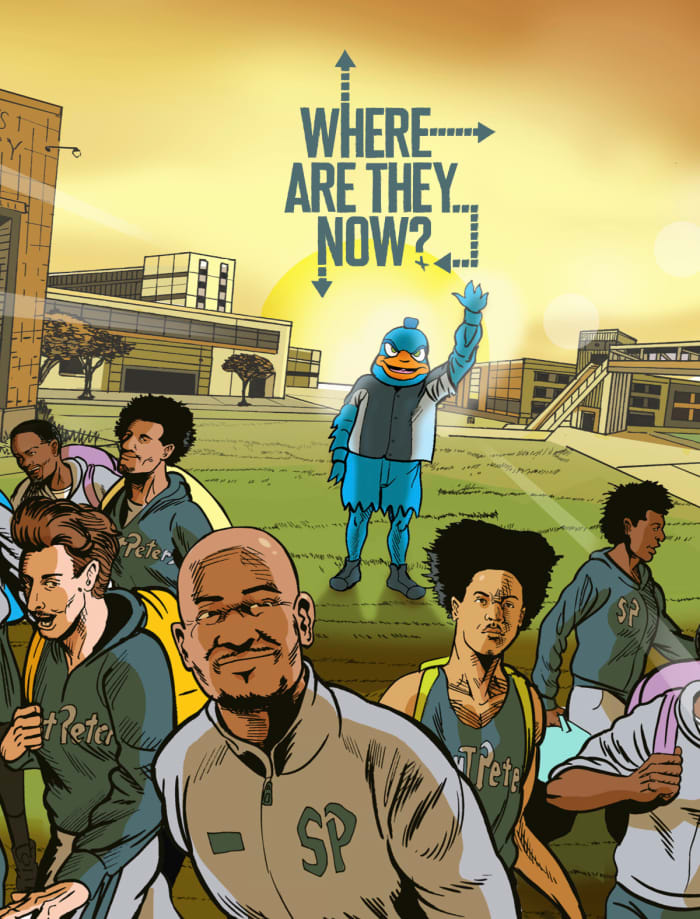Where Are They Now: Saint Peter’s basketball
[ad_1]
Each summer Sports Illustrated revisits, remembers and rethinks some of the biggest names and most important stories of our sporting past. Come back all week for more WHERE ARE THEY NOW? stories.
It’s June 15, 2022, 90 days since the average sports fan first learned who Doug Edert was. The face of Saint Peter’s men’s basketball is doing something remarkably ordinary for a college student on a Wednesday night: playing video games with his friends.
He’s joined by teammates from their March Madness run to the Elite Eight, Daryl Banks III and Matthew Lee. The game of choice? Call of Duty: Warzone.
Ask Doug what the world should know about him that it didn’t learn from watching him on national TV a few months before, and he’s not quite sure what to say.
“I’m just Doug,” Edert says. “I don’t know how to explain it. I play video games, I play basketball, I sleep and I eat.” He later adds that he takes video games, particularly Warzone, “very seriously.”
There’s a lot of interest in Edert, Banks and Lee these days. When Doug goes to the park with his younger brother, Justin, in his hometown of Nutley, N.J., he gets approached by fifth-graders asking him to sign his shoes. Banks is hosting autograph signings at baseball games and getting paid to post Instagram ads for Dove. Lee still hasn’t wrapped his head around the fact that fans sometimes stopped their cars in the middle of the street to take pictures with him on campus this spring.
Such is the life of college basketball’s greatest Cinderella ever, months after they entered the national consciousness. The March run made the Peacocks (and especially Edert, thanks to his facial hair and three-point shot) stars. They went from playing for a program that had 40 total season-ticket holders and a few hundred fans at most games to suiting up in front of a television audience of more than 10 million viewers.
Now, though, nearly the entire team is headed off in different directions, leaving the school they put on the map in favor of hopefully greener pastures. That Call of Duty game? It’s being played virtually, on headsets, over the internet—Edert in Rhode Island, Lee in Missouri and Banks just a few days away from heading to Western New York. And so begins the hard part, for both Saint Peter’s and the players and coaches that made up the Peacocks: figuring out what’s next.
A few days after Saint Peter’s Cinderella run came to an end in the Elite Eight against North Carolina, Shaheen Holloway gathered his team in the locker room back on campus. Ever since Seton Hall coach Kevin Willard had left for the Maryland job a little more than a week before, speculation about Holloway returning to his alma mater as the Pirates’ new coach had been rampant.
What should have been one of the hardest conversations a coach can have with his players became “easy,” in Holloway’s words. Why? His players had a message for him when the meeting began: take the Seton Hall job.
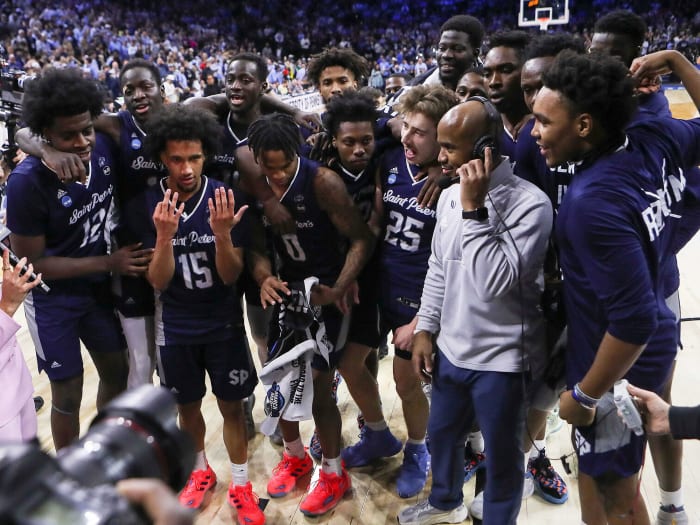
The Peacocks had a message for Holloway after their tournament exit: take the Seton Hall job.
William Bretzger/USA TODAY NETWORK
“That was the best place for Coach Shaheen,” guard Isiah Dasher says. “That was his school. We just felt like that was the best position for him to be in. He did everything he could for Saint Peter’s.”
Holloway has been tied to the Seton Hall program for more than half his life. Out of high school, he spurned offers from bigger programs to play some 15 miles from his high school in northern New Jersey. He played for the Pirates from 1996 to 2000, scored more than 1,500 career points, is the program’s all-time leader in assists and led it to its most recent Sweet 16. His first college coaching job was at Seton Hall under Bobby Gonzalez, and he made a name for himself in coaching as an assistant there for Willard. He also met his wife Kim at the school and has a daughter (from a previous relationship) who graduated from Seton Hall in ’18.
“How do you say no to home?” Holloway said at his introductory press conference. “It’s home.”
Once the decision was made, Saint Peter’s sat in the locker room for three hours. They reminisced, telling stories from the run, from years spent together, times that Holloway had yelled at them.
Scroll to Continue
“That moment, we all just came back to Earth and had fun,” Lee says. “I wouldn’t trade [that day] for anything.”
Losing Holloway may have felt like a certainty, but what would happen with the roster he left behind was an open question. Every player who appeared in the NCAA tournament still had eligibility remaining. Even with a new coach, that returning group would have a chance to repeat as MAAC champions. Players took time that weekend to talk about their future and eventually came to essentially the same conclusion: It was time to move on.
“It felt like it was going to be a fresh start at Saint Peter’s,” Lee says. “Obviously what we did was historic, but it was time to turn the page.”

Illustration by Felipe Flores
Read More Where Are They Now? Stories
And so began a mass exodus. Holloway was introduced at Seton Hall on March 31 and brought assistant coaches Ryan Whalen and Rasheen Davis with him. Edert, Lee and Banks (the team’s three top guards) entered the transfer portal within seconds of each other on April 5 and eventually landed at Bryant, Missouri State and St. Bonaventure, respectively. Later that week, twins Hassan and Fousseyni Drame went in the portal, which led them to a new home at La Salle. Talented freshman Clarence Rupert put his name in the portal on April 12 and is off to Southern Illinois, and KC Ndefo wrapped up a wave of departures by following Holloway to Seton Hall once he removed his name from NBA draft consideration.
All this happened as athletic director Rachelle Paul and the Saint Peter’s administration were trying to put in place a plan for the future, namely the hiring of a new coach. Some in college basketball circles were critical of Paul for taking too much time as a nearly two-week-long search wore on. But Paul was inundated with interest from candidates who, in some cases, she “could have never imagined” would want the job before the March run.
“There were people who didn’t think I was working fast enough, or that I could have promoted from within to save the roster,” Paul says. “Maybe that’s possible. We’ll never know. I didn’t feel like I could make a hasty decision on who’s going to be the next coach at Saint Peter’s because of where we were in that moment. And I truly believe that we got the best fit.”
That fit: Bashir Mason, who won three conference titles at Wagner and is a Jersey City native. He checks a lot of boxes: young, experienced and deeply familiar with the area. There are obvious similarities to Holloway as a young Black coach with deep ties to New Jersey and a hard-nosed, defense-first style. But while Mason says most of the players in the portal showed up to his first team meeting after taking the job, none elected to take their name out of the portal and go back to SPU.
“What they were able to do here was incredible, so yeah, it’s hard to see them go elsewhere to try to, I assume, do the same thing,” Paul says. “We can talk to them until we’re blue in the face about the benefits of staying at Saint Peter’s and getting a Saint Peter’s degree … but sometimes, it’s going to happen no matter what [we say].”
As all this was happening, the future former Peacocks were back in Jersey City. There was a parade down Kennedy Boulevard, a trip to the governor’s mansion and an outing to throw out the first pitch at a Yankees–Red Sox game, not to mention being treated like rockstars around campus for the remainder of the semester. Lee remembers walking into one class and having the professor interrupt a conversation with other students to give him a round of applause. Edert would get stopped and asked for autographs by his own classmates. Dasher, a Jersey City native, couldn’t believe the response to Saint Peter’s in the community and got stopped a few times while grocery shopping with his parents.
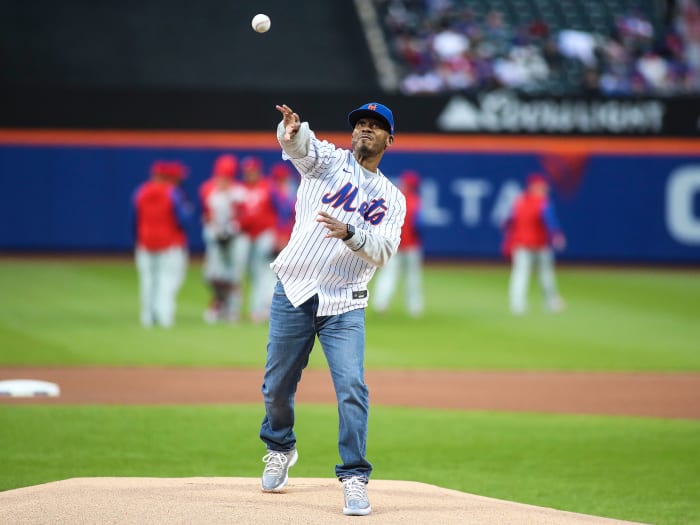
Holloway has had a busy schedule since Saint Peter’s March run. Here, he throws the first pitch at a Mets game.
Wendell Cruz/USA TODAY Sports
“Everything was just different,” Dasher says. “Like, the air was different. I don’t even know how to explain it.”
But the newly minted stars were also coming to terms with the fact that they were staring down the final moments they’d spend as a unit. In all, the team had 51 days between the season ending in late March and finals ending in mid-May. Edert kept a mental count of the days left before everyone went their separate ways as he’d hang around the dorms with Lee and his roommate Banks, playing video games and reminiscing about their time with the Peacocks.
“It was kinda sad, honestly, but we weren’t trying to think about that. We were just trying to have fun together,” Edert says. “Those days went by pretty fast.”
It has now been more than 100 days since Holloway coached his final game at Saint Peter’s. He still hasn’t found the time to sit back and watch the NCAA tournament games that made him the hottest commodity in college basketball.
As he lists all the things that have filled his calendar, dating all the way back to the food poisoning diagnosis that delayed his trip to Indianapolis for the tourney’s first round, it starts to make sense why he hasn’t had time for reflection. He was introduced at Seton Hall, then had to bury his grandmother Dorothy, who died the morning of the Elite Eight game. There were appearances at a Yankees game, a Mets game and a Devils game. At the NFL draft in Las Vegas, he announced the Jets’ third-round selection. Everyone wanted a piece of Holloway.
Mixed in, he had to start making the Seton Hall program his own. Holloway knows the ins and outs of the place, particularly from his eight years as a top assistant. He had a hand in recruiting many of the players that helped reignite the Pirates program, from highly touted guys like Isaiah Whitehead and Angel Delgado to projects like Desi Rodriguez and Khadeen Carrington, who became huge contributors. With several scholarships open this spring, Holloway went to work and landed five transfers, a freshman and convinced forward Alexis Yetna to return for his extra year of eligibility. By the time he officially landed Ndefo on May 28, Seton Hall was less than one week away from its players moving in for summer practice.
“It’s like, nonstop,” Holloway says.
Does he even want to look back, at this point? Holloway gives a positively Belichickian answer.
“That’s in the past. We’re moving forward. I’ve got a new challenge ahead of me,” Holloway says. “I don’t have time to do that. My job is to try to move forward.”
Holloway, like Bill Belichick, is extremely detail-oriented and not worried about frills or fame. He and his family haven’t moved houses since getting the new job (“I’ve got a big enough place already”) despite getting a pay raise that reportedly takes his compensation from around $300,000 annually to approximately $2.4 million anually.
“I don’t need luxury stuff,” Holloway says. “I’m not that type of guy, man. I’m lowkey.”
He may not need a fancier home, but there’s no question his new job comes with resources Saint Peter’s could only dream of. Seton Hall plays in the NBA-sized Prudential Center in Newark, which was the home of the Nets before their move to Brooklyn. It has plans to break ground on a new basketball-specific practice facility ballparked at $40 million, a figure slightly larger than Saint Peter’s endowment. Coaching in the Big East means better travel accommodations, bigger support staffs, more national exposure … you name it.
At Saint Peter’s, Holloway mined every available resource for talent. The Peacocks beat out better-resourced mid-majors for recruits like the Drame twins and Rupert, but success at a job like that also required finding talent others weren’t looking at. Lee, for instance, earned his spot originally as a walk-on by showing up to every summer open gym and later became a starter on the Elite Eight team.
The days of having to peruse the proverbial scrap heap for talent are over. Holloway has the Pirates involved with elite prospects in recruiting. Five-star big man Baye Fall visited campus in May, and top-40 recruit Scotty Middleton took an official visit in June. A host of other well-regarded prospects have also paraded through campus since Holloway took the job. Already known as one of the better recruiters in the Big East as an assistant coach, Holloway now has name recognition with elite prospects nationally thanks to the run at Saint Peter’s.
“Nobody can truly sell The Hall like Holloway can,” John Fanta, a Seton Hall alum who covers the Big East for Fox Sports, says. “The fact that he was the star of the NCAA tournament last spring gives him notoriety in any room he walks in.”
The same confidence that came through during March Madness echoes through Holloway’s voice now. The coach had a way of making the extraordinary sound ordinary when he’d address the media in press conferences that got bigger and bigger with each passing day in March. Seton Hall will never be the type of underdog Saint Peter’s was; Holloway seemingly expects to land top talent and keep winning.
“I’m used to this stage. I’m used to recruiting at this level. I know about it. I know how to do it,” Holloway says. “Seton Hall has had a lot of success. We’re not a school that’s just popping up … The past has been very good, and the future is going to be very bright.”
Take a stroll around Saint Peter’s campus these days, and you’ll find some tiny remnants of its 15 days of March fame. One electronic billboard at the front of campus still has Lee plastered on it with the caption “Strut Up” (an athletic department slogan). A poster that reads “JC Peacocks, America’s Team” fills the window of one row house on campus that doubles as the university’s facilities management office. A banner encouraging students to order team merchandise dangles over the balcony of the school’s student center. Walk through the athletic department offices on the second floor of the Yanitelli Center, and you’ll find one staffer’s office has a March Madness–branded placard with “Saint Peter’s Media Information” that was stolen from a tournament site taped up on his door as a souvenir. Another staffer has a copy of the New York Times paper that featured the Peacocks up on the wall behind his desk.
More prominently featured across the school’s athletic facilities, though, are nods to the previous Cinderella in program history: the 1967–68 “Run Baby Run” men’s basketball team, which beat Duke in the NIT. When the school renovated its basketball arena ahead of the 2021–22 season, the new facility was renamed Run Baby Run Arena. Plaques in the hallway that lead into the gym commemorate the lives and careers of the Run Baby Run players, including the eight from that team now in the Saint Peter’s athletics Hall of Fame. That includes Tom MacMahon, a major university donor who provided a leading $5 million gift to jumpstart the arena renovation. The 1968 team’s best player, Elnardo Webster, also has a plaque after averaging 25 points and 13.6 rebounds per game that season. Webster died in March, just days after the Peacocks beat Kentucky.
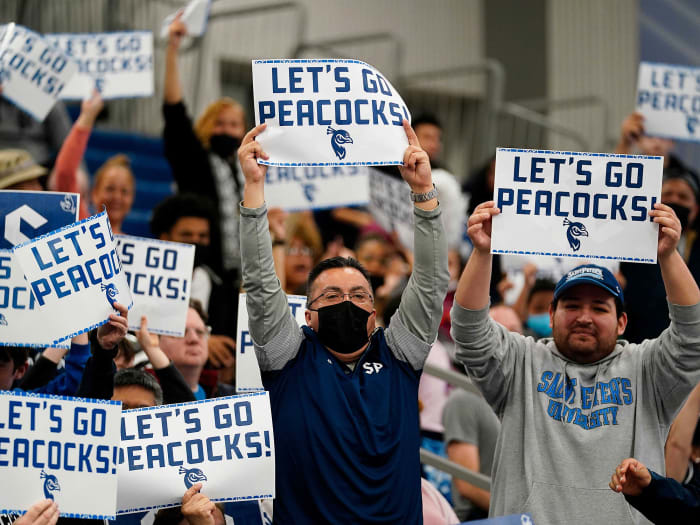
Saint Peter’s March success has spurred fan interest in the school, but will it be sustainable?
Danielle Parhizkaran/NorthJersey.com/USA TODAY NETWORK
A similar shrine for the 2021–22 Peacocks would make sense. But all this is happening in a far different era in NCAA athletics than the 1960s, when there was no transfer portal for Webster to enter. The majority of the players who’ll be synonymous with one of the great stories in recent college sports memory won’t get degrees from Saint Peter’s—only Ndefo leaves it with a diploma. It’s why Holloway had wanted the rest of the team to stay in Jersey City when he departed for Seton Hall, and why he says he didn’t recruit anyone other than Ndefo to follow him.
“I was hoping they would all stay,” Holloway says. “I can’t throw stones; I left. But … I wanted those guys to graduate from Saint Peter’s. I want those guys to be in the Hall of Fame. They’re going to be forever, ever remembered for what they did for a school like Saint Peter’s, for a town like Jersey City, for New Jersey. I wanted them to get the benefits of all the stuff that they did.”
But as the faces of Saint Peter’s men’s basketball move on, the lesser-known people in charge of keeping the school relevant get to work. The monthlong period from mid-March through mid-April as the Peacocks advanced through the tournament and then found a replacement for Holloway would have been a scramble for any athletic department, let alone one with a staff as tiny as Saint Peter’s has. Much of what the Peacocks pulled off away from the court, from watch parties to merchandise sales to billboards and welcome back celebrations, were planned almost entirely “by the seat of our pants,” Paul says.
“Everything happened so fast that we didn’t even have a chance to sit down as a staff and say, ‘O.K., when we beat Kentucky, you’re gonna do this, and we’re gonna do this,’” Paul recalls. “It just kind of happened. And somehow, some way, we figured it out.”
Now Saint Peter’s can sit down and make a plan, with the goal of capitalizing on its time in the spotlight. From a basketball perspective, the arena renovation getting done was a sign of things moving in a positive direction even before the run in March. Locker room and office renovations are next on the docket, as is a remodel of the school’s pool that’s just down the hall from Run Baby Run Arena.
“All eyes are on Saint Peter’s right now,” Paul says. “If people are going to come and we’re going to have recruits from high schools that are interested in Saint Peter’s, let’s look at what we can do to enhance the facilities here.”
This is where life at a small school differs from big-time college sports. Paul speaks of prioritizing investments in spaces used by general students like the pool to help the school boost enrollment. At a place like Saint Peter’s, the goal of building on a run like this isn’t just winning more games. It’s about growing enrollment and interest in a school that had little to make it stand out in the crowd just a few months ago. Early signs are positive: Paul says the school is seeing increases in enrollment inquiries, applications and housing deposits.
“Nobody really knew what [Saint Peter’s] was unless you were from Jersey City,” says Dasher, the only Jersey City native on the team and one of the few to return to the school for 2022–23. “It was always just a school that you could come to because it was cheap in a sense, or they would give you scholarships. It’s funny to see that people actually want to come to Saint Peter’s. It’s just so different now.”
It’s worth noting that, while lucrative, going to the Elite Eight doesn’t produce an immediate financial windfall for Saint Peter’s. The NCAA pays out “units” to each conference based on the number of tournament games played by the league. Pegging an exact value on those units is difficult, but Sportico projects a unit from the 2022 tournament to be worth a hair over $2 million, paid out in installments over six years. By playing four games instead of one, Saint Peter’s run will produce the MAAC about $6 million in additional revenue over the next six years. That money is likely to get divided equally among the league’s schools, working out to just under $100K a year each. That, plus huge surges in merchandise sales ($19,000 on the school’s online store in the week between the Round of 32 and Sweet 16, which Paul estimated as about a typical year’s worth in an interview with Sportico), are the main revenue increases for Saint Peter’s that are directly tied to its run.
That money is a big deal for a small department like Saint Peter’s, but it doesn’t fundamentally change a lot of the challenges at play for a “limited resource” outfit, as Paul calls the Peacocks. It doesn’t fund massive capital projects or even make Saint Peter’s one of the richer programs in its league, at least overnight. So to take on projects like pool renovations or locker room renovations, donor support is critical. That’s where the run could really pay dividends.
“Some of those [projects], we’re looking at a bit more seriously because of the success and the willingness of folks who want to say, ‘Hey, we want to contribute to Saint Peter’s,’” Paul says. “Hopefully now, the funding will come in a bit more quickly than in the past.”
But how long that bump lasts is dictated by the Peacocks’ on-court future. That’s why when Paul is asked what a successful 2022–23 academic year looks like for the school’s athletics in its first year after the run, she leads with one thing: win.
“Winning is contagious, and so now that our men’s basketball team has been able to do it … I think all of our student-athletes in every sport can now say, ‘They did it. Why can’t we do it?’” Paul says. “It changes the mindset.”
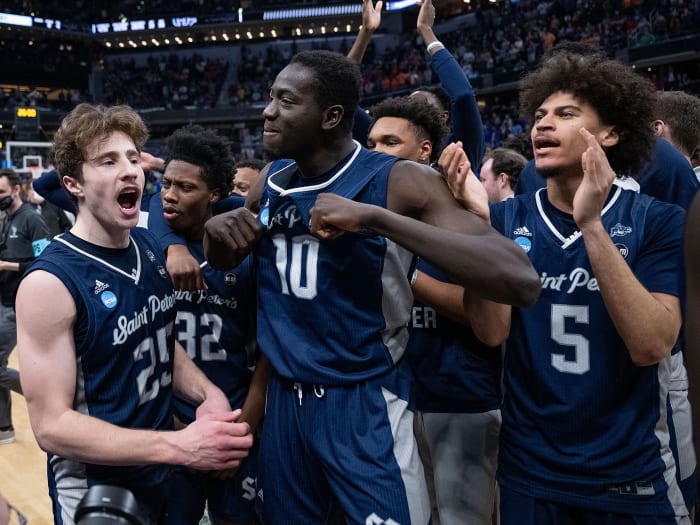
Edert (left), Fousseyni Drame (center) and Banks (right) were all among the Peacocks players to transfer out this spring.
Icon Sportswire/Getty Images
And the leader of that charge? Mason, heading up the men’s basketball program. Landing a proven winner at the Division I level was the first step, and Mason’s résumé from his time at Wagner (minus a trip to the NCAA tournament) speaks for itself in that regard. And as a Jersey City native, Mason was as invested as anyone when the Peacocks made their run in March, joking that during the NCAA tournament he was coaching the team from his living room. Now, he gets to do it from the sidelines, in his hometown. Who better to keep Jersey City invested in Saint Peter’s than one of its own?
“This is my neighborhood school,” Mason says. “I don’t want to be the guy that’s going to ruin it, and I’m not going to be the guy to ruin it.”
Texting and video games can replicate a lot of human interaction. That June 15 video game night, for instance, happened with Edert already in Rhode Island kicking off summer workouts at Bryant and Lee settling in at Missouri State. Consider this the new normal for a group Lee says is still “tied to the hip.” The group chats the team used to communicate while on campus are as active as ever. Former teammates plan to watch each other’s games. In some cases, they’ll even play against each other in conference play, as the Drames will take on Banks and Rupert will face off with Lee next season.
In the meantime, the current focus is getting comfortable in their new homes. Lee has been recognized a few times despite being halfway across the country from Saint Peter’s but says he mostly has gotten a fresh start. Edert quips that he doesn’t even know where all the buildings are on Bryant’s campus, but at least has figured out his way to the gym and has shared a few March Madness stories with his new teammates. Both players are still figuring out what their new routines look like, including answering one very important question: Who’s going to trim Edert’s famous mustache?
See, back in Jersey City, Lee would cut hair for several players on the team, including Edert. He’s the one who first gave Edert a mustache, after some prodding from Banks, midway through last season. Originally Doug planned on shaving it off the next morning, but he never did. The rest is history.
But with Lee and Edert now separated by nearly 1,400 miles, other arrangements for mustache maintenance need to be made. “I had to put on my big-boy pants and take on that role myself!” Edert says. “Matt was one of the very few people I trusted with it.”
Add it to the list of what’s new in a summer of change for the stars of March.
Read More Where Are They Now? Stories:
• John Amaechi: ‘You Want Gay People to Come Out: Make It So It’s Not S—-y’
• Steffi Graf Is Still Too Famous For Steffi Graf
• The GOAT Abides: Gary Smith, the Sportswriter in Repose
[ad_2]
Source link

